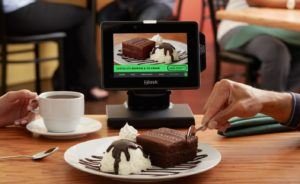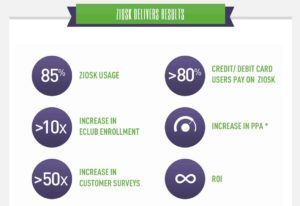Table-Top Kiosks: The Future of Restaurant Point of Sale Systems

Have you ever fell victim to horrible customer service at a restaurant? Olive Garden would argue these opportunities have come and gone. After incorporating a new table-top kiosk, this restaurant has provided customers with the ability to order and pay on-demand.
Darden Restaurants Inc. is the proud owner of a diverse portfolio of well-recognized restaurants to include Olive Garden, LongHorn Steak House, and Bahama Breez. With over 1,500 restaurants and 150,000 employees, Darden has long considered itself a forerunner when it comes to optimizing the use of technology in the casual dining industry [1]. So, when it came time for another point-of-sale (POS) upgrade in 2014, they were particularly looking for a transformative digital system that had the potential of creating enormous value for both their restaurants and their customers.
Emergence of Digital Technology in Restaurants
The crux of any restaurant is the menu, and this historically paper-based document has long been the main lever for restauranteurs to influence consumer purchases. It was only natural that this transaction emerged as one of the focus areas for the introduction of digital technology [2]. By the late 2000’s, restaurants across the world were experimenting with electronic menus on tablets and the feedback was resoundingly positive. Studies indicated that the digital version not only “improved customer service, … [but also] boosted sales [3].”
Olive Garden Introduces Ziosk
In late 2014, after viewing the initial successes of digital menus and having felt the benefits of prior digital POS systems, Darden decided it was time to incorporate a new product from the tech startup, Ziosk. Ziosk had merged the two technologies and created a table-side kiosk, which not only allowed the customer to browse a menu, but it also offered the ability to digitally place the order and pay. Darden made the agreement with Ziosk in April of 2015, and rolled-out the upgrade in its Olive Garden restaurant chain, 800-plus stores in total [4].
Figure 1: Table-Top Kiosk
Traditional Operating Model
Olive Garden’s previous operating model was traditional in nature with the wait staff at the center of all communication between the customer and the restaurant. Waiters and waitresses took the orders, inputted them into a digital POS, which then transferred the orders to the kitchen. They were also responsible for collecting payments. Even the best wait staff felt the tension of servicing all of these needs at once. It often left either an abundance of labor or disgruntled consumers. The Ziosk table-top kiosk fulfilled all of these needs in one.
New Operating Model
Costumers could now arrive to their table and place an order on-demand. Orders were transferred digitally directly to the kitchen without the inevitable lag of an intermediary. Food and drinks were equally as simple. Furthermore, the bill was developed digitally on the kiosk as orders were placed, and payments were as easy as swiping a credit card. Customers then had the option of receiving a digital or paper bill.
Outcome
Opportunities
Olive Garden anticipated many perks from this updated system. First, the kiosk offered the same benefits of a digital menu. They could update the menu frequently and effectively account for mass-customer preferences and supply. Second, with the increased efficiencies in the ordering process, the restaurant could now do more with less labor, significantly decreasing their operating costs. Lastly, the kiosk provided an expedient method for customers to enroll in the revenue-producing loyalty programs [5]. The Ziosk product offered an array of value that was previously inaccessible. Initial reports showed an increase in dollars spent per order and an average drop of 10 minutes in time spent by customers at a table [6].
Figure 2: Kiosk Successes
Challenges
Such abundant changes do not come without its fair share of risks. Though Olive Garden would assert that this system allows their “team members to … provide a more personalized service [7],” it would be negligent to assume that there is not some type of psychological connection to the traditional operating model. There is risk in curbing any consumer perception, and Olive Garden will certainly have to devote some capital to accomplishing such a change successfully. In addition, they must pay close attention to the incomes of their wait staff. It may be necessary for them to adjust their incentive structure if they begin to make less on tips as the result of customers perceiving the kiosk as adding most of the value.
Further Opportunities
Despite the challenges, this addition of digital technology is most likely a win-win. Though 85% of customers are using the kiosk [8], by no means has Olive Garden made it mandatory. As a result, they were able to tap into the value the technology offers, while also providing the same traditional method that a segment of customers still prefers.
In conclusion, it is important to note that there is still further value to be created with this technology. Similar to other digital products, this kiosk is producing a vast quantity of data that could be used to further exemplify customer service. Imagine arriving at a table with your preferred drink already waiting for you or receiving a menu specifically made to meet your individual preferences. All of this is in the future for Darden and its restaurant portfolio.
[Word Count: 799]
End Notes
[1] Darden Restaurants Inc., “Our Company,” https://www.darden.com/our-company/about-us, accessed November 2016.
[2] Nadria Buchanan, “An Examination of Electronic Tablet Based Menus for the Restaurant Industry,” University of Delaware (2011), http://udspace.udel.edu/ handle/19716/10138, accessed November 2016.
[3] Srikanth Beldona , Nadria Buchanan , Brian L. Miller, “Exploring the promise of e-tablet restaurant menus”, International Journal of Contemporary Hospitality Management, Vol. 26 Iss: 3, pp.367 – 382 (2014), http://dx.doi.org/10.1108/IJCHM-01-2013-0039, accessed November 2016.
[4] Tyler Gaskill, “Turning the Tables,” Quality Progress 48.8 (Aug 2015): 10-12, http://search.proquest.com/openview/dbd162f8cc4e8b76ffa9b90f28234bda/1?pq-origsite=gscholar-, accessed November 2016.
[5] Ibid.
[6] Ibid.
[7] Ziosk, “Ziosk Olive Garden Press Release,” http://ziosk.com/docs/Ziosk OliveGardenPressReleaseFINAL.pdf, accessed November 2016.
[8] Ziosk, “Home,” http://www.ziosk.com/#home, accessed November 2016.
Figures
[1] Ziosk, “Home,” http://www.ziosk.com/#home, accessed November 2016.
[2] Ibid.






John, this is an interesting manifestation of technology in the restaurant industry. I agree that there is a lot for Darden to celebrate: higher table turnover leads to higher nightly revenue (presuming they have the demand), higher per table spending results in higher tips, higher loyalty program reinforces this cycle.
My grandparents love Olive Garden and we had our first foray into the Ziosk tableside assistant world in the last year. I was quite curious how older clientele would react; while my grandparents were not exactly sure what to make of it, they were interested in completing the survey and in having the device notify our waiter when we needed something (extra breadsticks…). While there is still an initial hurdle to use to ensure it doesn’t alienate a base of its customers, as you mention, the traditional service is also available.
I would be interested to hear how waiters feel about the service- does it freeing up their time enable them to make more money and thus make them happy, or does it erode the value they thought they were providing, resigning them to an order taker/deliverer?
This also may have functionality to keep kids occupied at dinner, presuming parents are okay with their children playing games, and that one consul does not result in fights between kids.
Lastly, I wonder what value they will be able to derive from the data (not limited to but including the customer survey). Perhaps this will help bring Olive Garden to the next level.
Thanks for the read, John! Great food for thought… pun very much intended.
To build on Colleen’s points, I’m curious to see what this technology does for the dining experience. My sense is Darden’s restaurants fall in the fast casual segment – often a family affair, seated dining that’s both fast and friendly, etc. Do you think table-top kiosks will ultimately improve the dining experience by reducing order errors and freeing up time for waiters to focus on customer service (answering questions, refilling drinks, fulfilling ad hoc requests), or will they have the opposite effect as customers are now more focused on the tablet rather than interaction? Also, to Colleen’s point, I wonder about the learning curve for customers – I imagine for the less technologically literate customer, like Colleen’s grand parents, the staff will have to explain how the tablets work. There’s also a learning curve for waiters as they are now the go-to for tech-related issue resolution. At the end of the day, I think table-top kiosks are a terrific idea if Darden’s goal is to optimize on KPIs like turnover and ticket size, so long as it isn’t at the expense of the customer experience.
Thanks, John – really interesting post. I definitely see the value that this technology can provide particularly in the fast casual and pure fast food segments. It’s actually a bit surprising that digital doesn’t feature more prominently at fast food establishments – seems like this could reduce wait time even further. I’m particularly curious to see how similar technologies could be applied in more upscale restaurants – I have a tough imagining this taking off, as it seems to cheapen the experience. It will be interesting to see how the roles of waitstaff are impacted by such shifts.
Nice post, John.
I think the utilization of Ziosk-esque devices in restaurants will really depend on answering the question “what do consumers truly value when they dine at restaurants, and how does that vary by class of restaurant?” I wonder how limited the range of restaurants this could be used for? One aspect of the fast casual scene (e.g. Qdoba, Blaze Pizza) is that you can watch as your food is prepared, which I think appeals to the customer vs. solely ordering everything in advance. Fast food, on the other hand, as Japser mentioned may not be entirely appropriate for this type of technology. For instance, Taco Bell developed an application where a consumer can order in advance from their smart phone, rather than a kiosk.
I think that this type of product could move to more upscale restaurants in different scenarios. Increased efficiency appears to be the greatest value-add of this technology for me. Perhaps you could add these for quick executive lunches or expedited bar service.
Very interesting post John. It is really great what Ziosk has done in a restaurant like Olive Garden. I wonder if this kind of applications also can help restaurants with managing their inventories and utilizing the system for a faster and more effective accounting control, analyzing live costs and revenues. I could also imagin applications like stats on the most popular dishes and live modification of prices. The good think also is that this technology is designed for any kind of restaurant or even a pub and they don’t need to invest in expensive equipment. I really think that through the following years we will see more and more restaurants going in this direction, and at the end we will see less waiters or better said “middle men” on restaurants. The only problem I can see with this, is that restaurants will lose the human side of the whole experience, as we won’t have somebody making as recommendations and trying to improve our experience, specially for “foodies” like me, that we are always trying to taste new dishes and get good advises on every restaurant that we go.